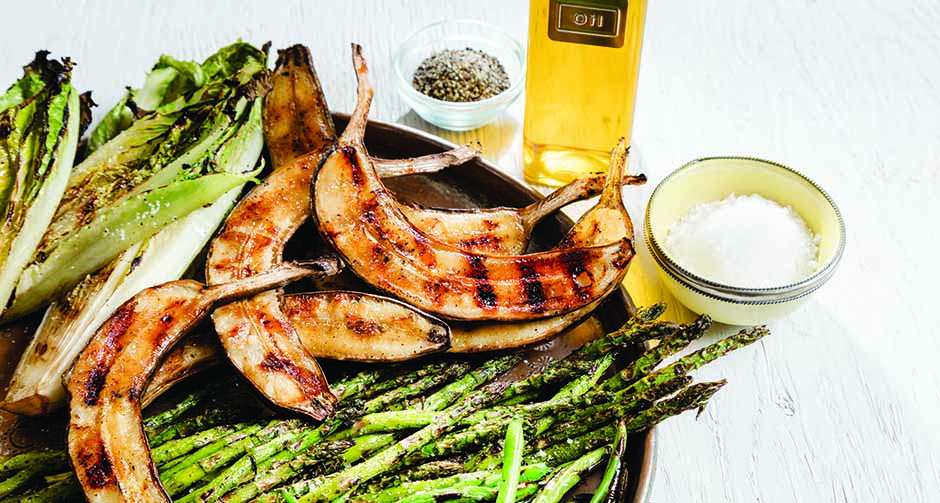If you can eat it, you can grill it. That is the motto of Elizabeth Karmel, founder of Girls at the Grill (girlsatthegrill.com) and author of several cookbooks on the topic. “The gateway to getting people to grill is for them to choose foods that they like, and knowing the difference between direct and indirect heat,” says Karmel. Then it’s as simple as using Karmel’s grilling trilogy: olive oil, salt and pepper.
ASPARAGUS
“The natural heat of the grill caramelizes the natural sugars in asparagus, giving it a roasty, toasty flavor,” says Karmel. “Grilled asparagus is finger food at its best!”
How to grill: Coat with olive oil and salt, plus pepper if desired. Cook over direct heat, 5–6 minutes, turning occasionally until all sides are blistered.
GREEN BEANS
“This is the only way I’ll eat green beans,” says Karmel. “Grilling brings out the flavor that you won’t get if the beans are steamed.”
How to grill: Coat with olive oil and salt, plus pepper if desired. No need for a vegetable grilling basket. Place beans directly on the grill in the opposite direction of the grates. Cook over direct heat, 3–4 minutes, turning once for grill marks.
BANANA
This is Karmel’s favorite fruit to grill. “I fell in love with bananas Foster in New Orleans, but making it with all the butter can be such a mess. So I created a grilling recipe that is unbelievable!”
How to grill: Mix up a rub of cinnamon sugar and a touch of salt. Cut a banana lengthwise, keeping skin on; you’ll have two long halves. Lightly coat with olive oil, and sprinkle on cinnamon/salt rub. Place face down on grill; then cook 2 minutes over medium-low direct heat. Turn over on skin side, put grill lid on, and let cook until skin pulls away from the flesh. Serve with ice cream, pecans and bourbon (for adults!) to make a delicious sundae.
ROMAINE LETTUCE
“Everybody loves a wedge salad,” says Karmel. Serve grilled romaine with vinaigrette, blue cheese and a bit of bacon. Or bake prosciutto in a 300-degree oven on parchment paper for a few minutes. “It crumbles like bacon and is leaner,” says Karmel.
How to grill: Split head of romaine in half; coat with olive oil, salt and pepper. Place on grill over direct heat; sear each half on both sides.
TIP
DO coat food (vegetables, fruit, fish, meat) with olive oil, says Karmel. It keeps in the natural juices and also promotes caramelization for added flavor.
TIP
DON’T oil the grill grates. Why? Karmel explains that oil burns quickly, so it dehydrates food. It also gets sticky, so it will end up gluing food to the grates.
TIP
DO use olive oil. DON’T use vegetable oil; it has a thinner viscosity, so it’s more apt to drip and create flare-ups.
Direct vs. Indirect Heat
Whether you are fond of gas grills or charcoal, there are two types of fires to master—direct and indirect heat. “If food takes 20 minutes or less to cook, use direct heat,” says Karmel. “If it takes more than 20 minutes, use indirect.”
Direct heat is evenly spaced across the entire grill for both gas and coals. A hot fire means you can hold your hand over the fire 3 inches above the grate for no more than 3 seconds before you have to pull your hand away.
Indirect heat is divided into two temperatures, hot and cool. A middle cool section is sandwiched by live gas-grill flames or hot coals on each side. A charcoal grill rack holds the coals in place, or you can simply push the coals aside. This method is preferred for recipes that need longer cooking times, like chicken and vegetables.

